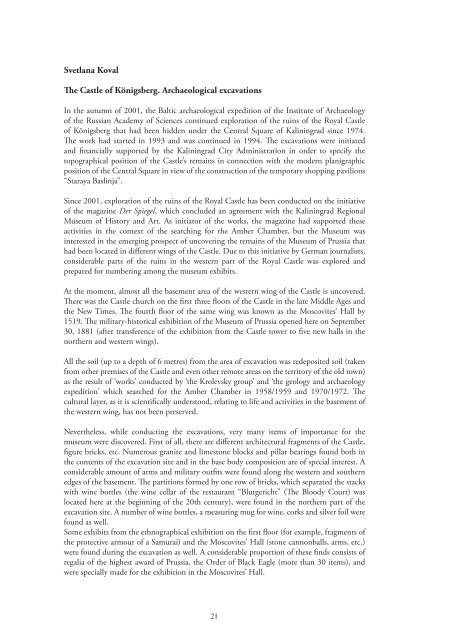BALTIC MEETINGS - Baltic Writers Council
BALTIC MEETINGS - Baltic Writers Council
BALTIC MEETINGS - Baltic Writers Council
Create successful ePaper yourself
Turn your PDF publications into a flip-book with our unique Google optimized e-Paper software.
Svetlana Koval<br />
e Castle of Königsberg. Archaeological excavations<br />
In the autumn of 2001, the <strong>Baltic</strong> archaeological expedition of the Institute of Archaeology<br />
of the Russian Academy of Sciences continued exploration of the ruins of the Royal Castle<br />
of Königsberg that had been hidden under the Central Square of Kaliningrad since 1974.<br />
e work had started in 1993 and was continued in 1994. e excavations were initiated<br />
and financially supported by the Kaliningrad City Administration in order to specify the<br />
topographical position of the Castle’s remains in connection with the modern planigraphic<br />
position of the Central Square in view of the construction of the temporary shopping pavilions<br />
“Staraya Baslinja”.<br />
Since 2001, exploration of the ruins of the Royal Castle has been conducted on the initiative<br />
of the magazine Der Spiegel, which concluded an agreement with the Kaliningrad Regional<br />
Museum of History and Art. As initiator of the works, the magazine had supported these<br />
activities in the context of the searching for the Amber Chamber, but the Museum was<br />
interested in the emerging prospect of uncovering the remains of the Museum of Prussia that<br />
had been located in different wings of the Castle. Due to this initiative by German journalists,<br />
considerable parts of the ruins in the western part of the Royal Castle was explored and<br />
prepared for numbering among the museum exhibits.<br />
At the moment, almost all the basement area of the western wing of the Castle is uncovered.<br />
ere was the Castle church on the first three floors of the Castle in the late Middle Ages and<br />
the New Times. e fourth floor of the same wing was known as the Moscovites’ Hall by<br />
1519. e military-historical exhibition of the Museum of Prussia opened here on September<br />
30, 1881 (after transference of the exhibition from the Castle tower to five new halls in the<br />
northern and western wings).<br />
All the soil (up to a depth of 6 metres) from the area of excavation was redeposited soil (taken<br />
from other premises of the Castle and even other remote areas on the territory of the old town)<br />
as the result of ‘works’ conducted by ‘the Krolevsky group’ and ‘the geology and archaeology<br />
expedition’ which searched for the Amber Chamber in 1958/1959 and 1970/1972. e<br />
cultural layer, as it is scientifically understood, relating to life and activities in the basement of<br />
the western wing, has not been preserved.<br />
Nevertheless, while conducting the excavations, very many items of importance for the<br />
museum were discovered. First of all, there are different architectural fragments of the Castle,<br />
figure bricks, etc. Numerous granite and limestone blocks and pillar bearings found both in<br />
the contents of the excavation site and in the base body composition are of special interest. A<br />
considerable amount of arms and military outfits were found along the western and southern<br />
edges of the basement. e partitions formed by one row of bricks, which separated the stacks<br />
with wine bottles (the wine cellar of the restaurant “Blutgericht” (e Bloody Court) was<br />
located here at the beginning of the 20th century), were found in the northern part of the<br />
excavation site. A number of wine bottles, a measuring mug for wine, corks and silver foil were<br />
found as well.<br />
Some exhibits from the ethnographical exhibition on the first floor (for example, fragments of<br />
the protective armour of a Samurai) and the Moscovites’ Hall (stone cannonballs, arms, etc.)<br />
were found during the excavation as well. A considerable proportion of these finds consists of<br />
regalia of the highest award of Prussia, the Order of Black Eagle (more than 30 items), and<br />
were specially made for the exhibition in the Moscovites’ Hall.<br />
21


